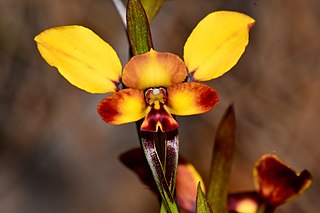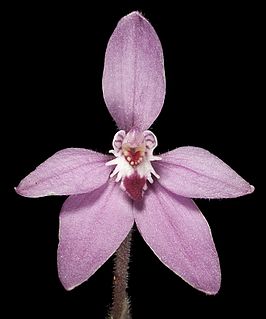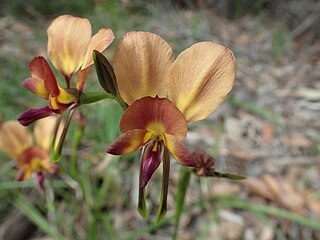
Diuris brumalis, commonly known as the winter donkey orchid, is a species of orchid that is endemic to the south-west of Western Australia. It is one of the first species of donkey orchid to flower in Western Australia each year and its flowers have been shown to attract the same insects that pollinate other species, but without offering a food reward.
Diuris carinata, commonly known as the tall bee orchid, is a species of orchid that is endemic to the south-west of Western Australia. It has between four and six leaves and up to seven large, bright yellow flowers with reddish-brown markings.

Diuris corymbosa, commonly called the common donkey orchid or wallflower orchid, is a species of orchid which is endemic to the south-west of Western Australia. It is similar to the purple pansy orchid but its flowers are yellow rather than purple or mauve and it flowers earlier in the year. It also resembles the winter donkey orchid but flowers later than that species. It is one of the most common orchid species in the Perth area, often forms extensive colonies and usually has numerous flowers on the one spike.

Diuris porrifolia, commonly called the small-flowered donkey orchid is a species of orchid which is endemic to the south-west of Western Australia. It has two or three leaves and up to seven yellow flowers with brown or reddish markings. It is similar to the common donkey orchid but its flowers are smaller and it has a more easterly distribution.

Diuris drummondii, commonly known as the tall donkey orchid is a species of orchid which is endemic to the south-west of Western Australia. It is the tallest Diuris and is distinguished from the similar Diuris emarginata by its larger, more widely spaced flowers. The flowers are pale yellow with brown markings.

Caladenia filifera, commonly known as the blood spider orchid, is a species of orchid endemic to the south-west of Western Australia. It has a relatively common orchid in its natural range, often forming clumps, and has a single hairy leaf and up to three blood-red flowers.

Caladenia reptans subsp. reptans, commonly known as the little pink fairy or dwarf pink fairy, is a plant in the orchid family Orchidaceae and is endemic to the south-west of Western Australia. It has a single hairy leaf and up to three relatively small, pink flowers which have a labellum with three distinct lobes.
Caladenia reptans subsp. impensa, commonly known as the pale pink fairy, is a plant in the orchid family Orchidaceae and is endemic to the south-west of Western Australia. It has a single hairy leaf and up to three pale pink flowers which have a labellum with three distinct lobes. It is similar to subspecies reptans except that its leaf is green on both sides and the flowers are larger and on a taller flowering spike.

Diuris conspicillata, commonly called the spectacled donkey orchid is a species of orchid which is endemic to the south-west of Western Australia. It is an uncommon species, only found on two coastal granite outcrops, growing in shallow soil pockets.

Diuris magnifica, commonly called the large pansy orchid is a species of orchid which is endemic to the south-west of Western Australia. It has large, colourful flowers and is common in a narrow range near the coast around Perth, often occurring with the similar but smaller Diuris corymbosa.
Diuris amplissima, commonly called the giant donkey orchid is a species of orchid that is endemic to the south-west of Western Australia. It is a rare species and the largest Diuris in Western Australia. It has two or three leaves at its base and up to seven purple and dull yellowish-brown flowers on a tall flowering stem.

Diuris concinna, commonly called the elegant donkey orchid, is a species of orchid which is endemic to the south-west of Western Australia. It has up to five linear leaves at its base and up to five pale yellow flowers with brown markings. It is found along the south coast, often growing in areas that are flooded in winter and flowering more prolifically after fire the previous summer.
Diuris heberlei, commonly called Heberle's donkey orchid, is a species of orchid which is endemic to the south-west of Western Australia. It has three to five linear leaves at its base and up to four bright yellow flowers with a reddish brown border around the labellum callus. It is found along the south coast and is one of the last Diuris to flower in Western Australia.
Diuris immaculata, commonly known as the little Esperance bee orchid, is a rare species of orchid that is endemic to the south-west of Western Australia. It has between four and six leaves and up to three golden yellow flowers without markings. It is only known from near Esperance.

Diuris laevis, commonly known as the nanny goat orchid, is a rare species of orchid that is endemic to the south-west of Western Australia. It has between four and eight leaves and up to six pale yellow flowers which usually have reddish-brown markings. It has an unusually short dorsal sepal and wide labellum and is relatively common between Bunbury and Albany.
Diuris micrantha, commonly called the dwarf bee orchid or tiny bee orchid, is a rare species of orchid which is endemic to the south-west of Western Australia. It has four to six linear leaves at its base and up to six yellow flowers with reddish brown markings. It grows in swampy places south of Perth.

Diuris purdiei, commonly known as Purdie's donkey orchid, is a species of orchid that is endemic to the south-west of Western Australia. It has between five and ten leaves at its base and up to eight pale yellow flowers with reddish-brown or purplish markings. It mainly grows in swampy areas and only flowers after fires the previous summer.
Diuris recurva, commonly called the mini donkey orchid is a species of orchid that is endemic to the south-west of Western Australia. It has one or two leaves at its base, up to six small pale yellow and brownish flowers and grows in winter-wet places between Badgingarra and Kalbarri.

Diuris setacea, commonly called the bristly donkey orchid, is a species of orchid that is endemic to the south-west of Western Australia. It has a tuft of up to ten twisted leaves at its base and up to seven yellow flowers with a few brown markings. It grows in moist soil on granite outcrops and flowers much more prolifically after fire the previous summer.

Diuris jonesii, commonly known as Dunsborough donkey orchid, is a species of orchid that is endemic to the south-west of Western Australia. It has large, yellow, brown and mauve flowers and is found in near-coastal areas between Dunsborough and Augusta.













